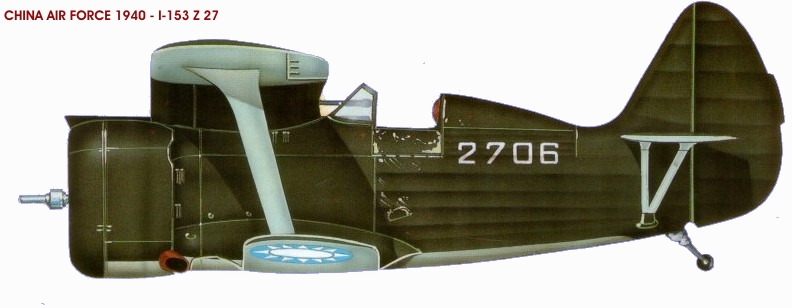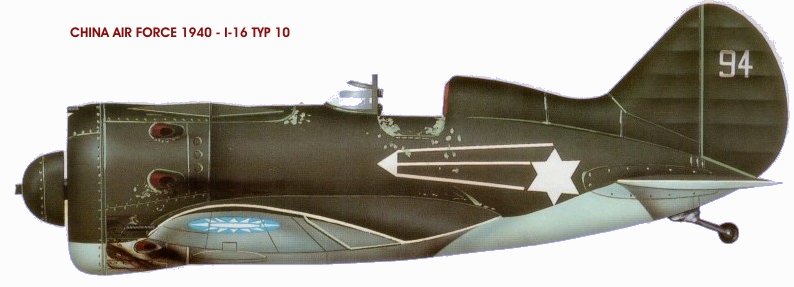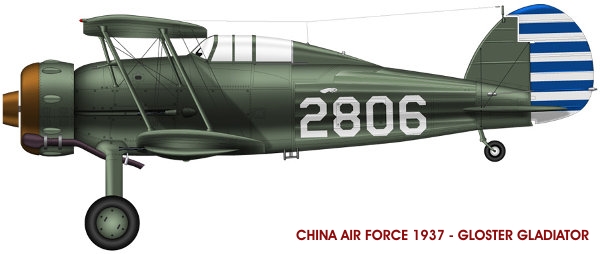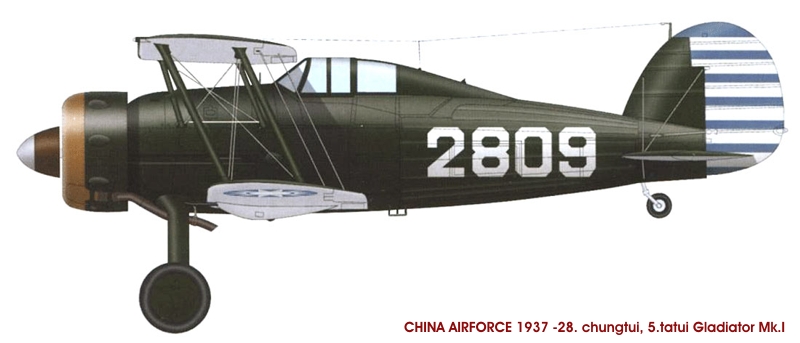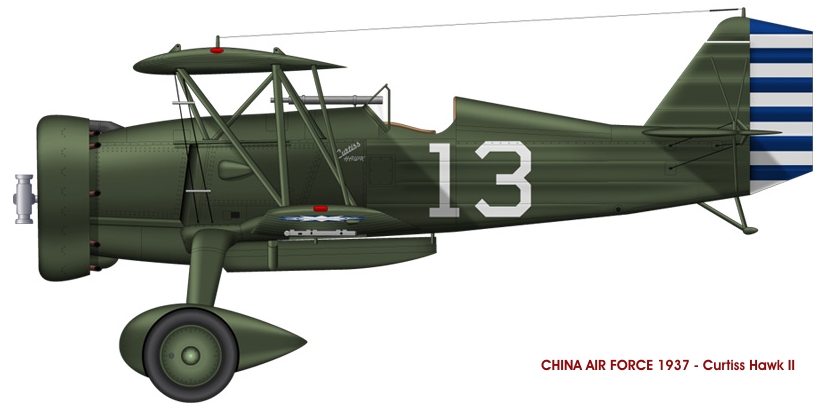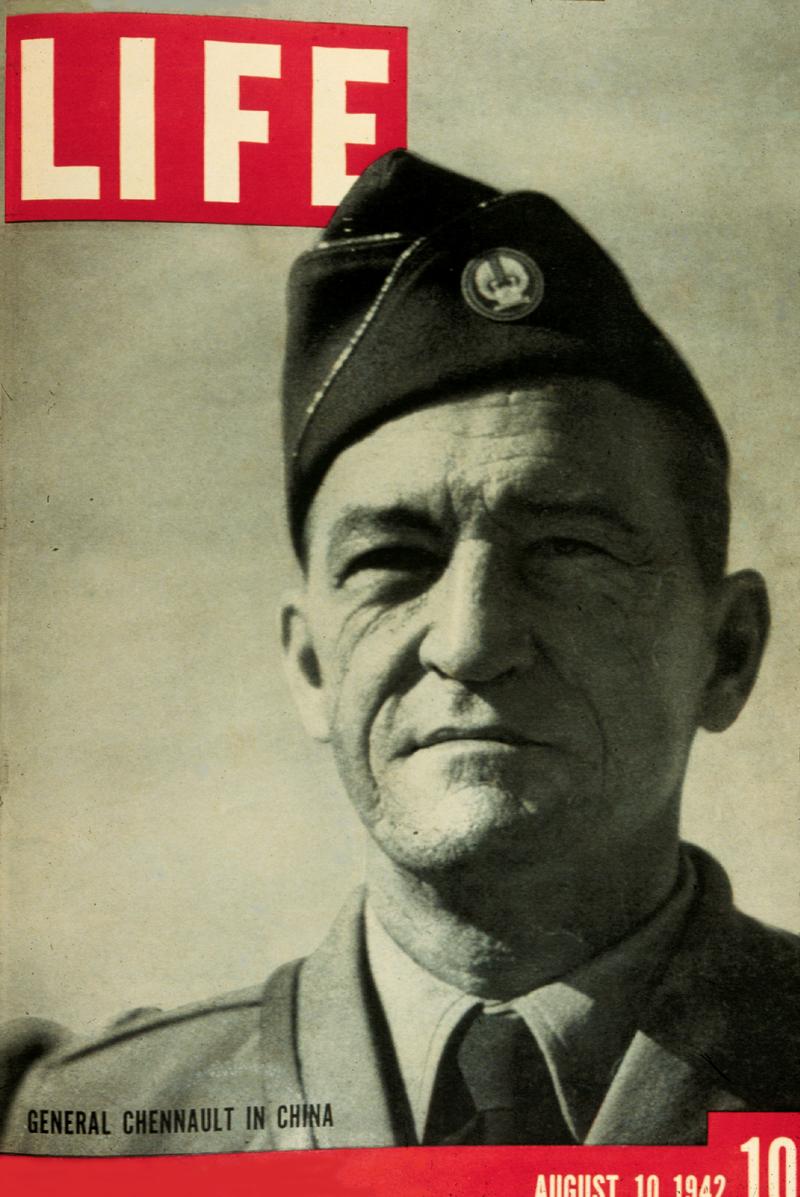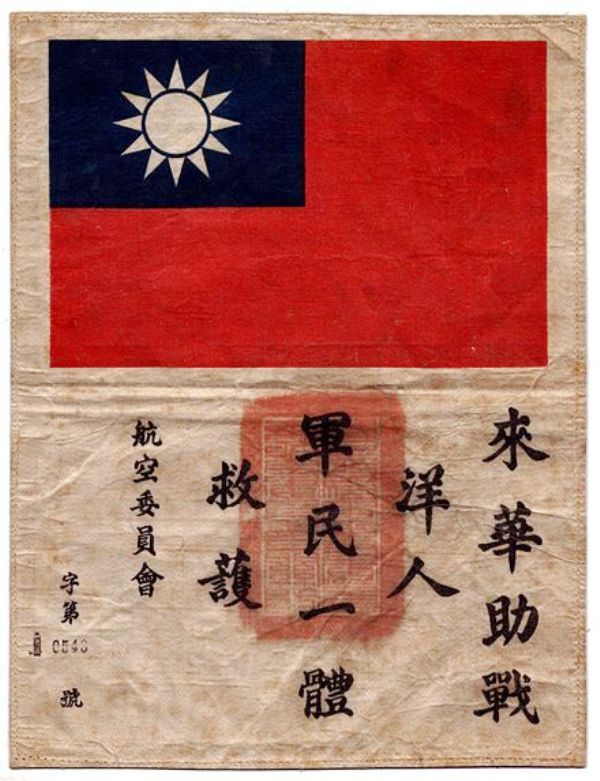
The Boeing Model 281 was the export version of the first P-26C. It had the same carburetor engine used in the first ‘C’ versions, a new high headrest, and wing flaps. The 281 was actually on the assembly line before the ‘C’ and was used to develop the wing flaps needed to reduce the landing speed. The Model 281 made its maiden flight in Dec 1934. The Chinese Air Force aircraft were ordered in 1934 but because of funding problems didn’t arrive until 1936. In 1934 the Chinese Air Force ordered 11 Model 281 aircraft, the export version of the Boeing P-26. The Peashooters were assigned to the 17th Pursuit Squadron of the 3rd Pursuit Group based at Chuyung Airfield near Nanking. The aircraft were delivered with an overall light grey with large black letters. In mid-August 1937 the 17th Pursuit Squadron began defending Nanking from Japanese G-3M attacks. Due to losses from the new Japanese A-5M and a lack of spare parts the Model 281 was out of service when Nanking fell on December 13, 1937.
Chennault always argued that the Douhet theory was fatally flawed in that the bombers could be detected and once detected, their target could be ascertained, and then the bombers could be intercepted. He proved his theory for his own benefit in the 19th Pursuit Squadron, in his correct interpretation of the war games of the 1930s, and now he would be able to prove the detectability fallibility of the unescorted bomber in combat. Apparently, the Japanese had read and believed the Douhet theory for they used unescorted bombers almost exclusively from the 1931 occupation of Manchuria until August of 1937. It remained to be seen if the early warning net would work in combat. The interception of the enemy bombers was the third tier of Chennault’s theory. Once the enemy bomber fleet was detected, the fleet had to be intercepted. Chennault found that World War interception was due to luck or accident. Regardless, this left the pursuit with one method of attack, to close with one machine gun versus the bombers’ six or eight machine guns. Chennault recorded from the Antiaircraft-Air Corps exercise at Fort Knox in 1933 that interceptions were made from information from the ground and air observers and from each source separately. Vectoring pursuit to intercept bombers by a direct route conserves the defensive effort. Placing the pursuit between the enemy’s probable objectives and his invading force allows the pursuit to maneuver on shorter, interior lines.
Further economies of defense are achieved by sending the minimum necessary force to disrupt each hostile attack. Airplanes required to patrol areas, where the enemy does not appear, are conserved and available for other missions. Pursuit operations using a line-of-flight scheme of maneuver possess all the advantages inherent to the defensive attitude of any military force by minimizing defensive effort while forcing the enemy to greatly increase his effort expenditure. Interception before the fleet reached their intended target area was greatly preferable as it disrupted the attack. Chennault wrote: Defending pursuit could make interception of attacking bombardment before the bombers reached their target if furnished timely information and if the interception area had sufficient depth to allow for necessary time factors. Bombardments flying deep into enemy territory required friendly fighter protection to prevent heavy losses if not an utter failure of the mission.
The main objective is the destruction of hostile bombers before bombs are dropped on their targets. The subsequent objective is the destruction of the enemy while attacking withdrawing, or on the ground at their own airfields. Destruction of the enemy air force key industries and the ability to wage war was the fourth element of Chennault’s theory. Chennault used three precepts to show that defense against and destruction of the enemy bombardment was possible. First, he used the weapon counter-weapon argument; second, he employed the concept of mass; and third, he used interior lines to argue that the bomber was not invincible. Using the weapon counter-weapon argument, Chennault showed that pursuit planes armed with .50 caliber machine guns had adequate standoff to destroy bombers. Using the theory of mass through teamwork, he advocated that three fighters attacking from three directions should concentrate their total volume of fire while the defensive fire from the bombardment formation must be dispersed in at least three directions. He added to his earlier use of interior lines for interception by writing that the leverage gained from fighting over friendly territory imposed little penalty in the downing of a friendly plane while the enemy plane and crew are removed from the enemy’s order of battle. With this argument, Chennault established for aerial warfare the well-known principle that the defense is more economical than the offense.
Chennault did not discount the bomber’s offensive utility. He wrote that the bomber’s offensive effectiveness is maximized when it is used against, industrial establishments, and lines of communication and supply which contribute to the enemy’s ability and will to resist. He argued that the nation’s ability to wage war can be crippled and perhaps destroyed by an enemy employing a vast number of bombers against factories, lines of communication, mobilization centers, centers of wealth and population, and harbors. Chennault argued that the bomber was not immune from attacks from pursuit aircraft. In the 1930’s it was a difficult position to take since the faster multi-engine bombers easily outpaced the pursuit aircraft of the era. Chennault urged the development of a pursuit that could outclimb, outpace, and equal the range of the bombers so that it could be used first to destroy the enemy bombers and second to escort and protect friendly bombers. More than just a pursuit-bomber fleet, Chennault argued for a balanced air arm that included an early warning net and an observation fleet.
Chennault had no argument with bomber usage, for he used bombers with great skill in China, but he surgically attacked Douhet’s apostles who claimed the bomber was an end to itself. In building his case for defensive pursuit, Chennault readily acknowledged that whether an entire nation can be conquered by bombardment is a debatable question. Yet, he balanced his argument by adding a nation deprived of the means for waging war will not maintain the desire to fight very long. His argument for defensive pursuit used the military method of understanding a weapon’s capabilities and limitations before constructing a defense against the weapon. During the process of advocating a balanced force, he noted the bomber’s limitations: airdromes, large supplies of armaments and fuel, corps of highly trained operators and mechanics, altitude, and visibility restrictions. Chennault also added some immediate challenges for pursuit: the use of emergency fields for war operations and the camouflage, defense, and supply of those fields should be studied more thoroughly; communications should be studied with a view to reducing the time required for taking off on interception missions; point interceptions should be practiced; an information net controlled by the air force commander should be developed; marine observation-listening posts for use in defending seacoasts points should be developed
 The Army Ground Forces (AGF) and the War Department (WD) rated the destruction of the enemy army as above the other concerns, as recorded in 1923’s and subsequent editions of Field Service Regulations. Chennault agreed with other theorists of the interwar years that the most efficient role for an Air Arm is not to be tied to the immediate ground battle. They argued that attacking enemy ground forces usually constituted the least remunerative method for employing bombers. The enemy ground forces disperse, use shelter, and maintain their morale during and after attacks. Even though the air arm can decisively contribute to the tactical ground battle, the greatest utility of the air arm comes from its inherent flexibility and ability to mass.
The Army Ground Forces (AGF) and the War Department (WD) rated the destruction of the enemy army as above the other concerns, as recorded in 1923’s and subsequent editions of Field Service Regulations. Chennault agreed with other theorists of the interwar years that the most efficient role for an Air Arm is not to be tied to the immediate ground battle. They argued that attacking enemy ground forces usually constituted the least remunerative method for employing bombers. The enemy ground forces disperse, use shelter, and maintain their morale during and after attacks. Even though the air arm can decisively contribute to the tactical ground battle, the greatest utility of the air arm comes from its inherent flexibility and ability to mass.
AVIATION TRAINING
As he noted after the 1934 maneuvers, the enemy ground force can be reinforced ad infinitum until the friendly combatants cut off the enemy lines of communication or, preferably, the enemy’s ability to wage war. Chennault authored his theory from 1933 to 1936. He outlined his strategy for the theater in 1937. He authored his operations and tactics for the China theater in 1940. He refined these ideas with his observations of the Japanese, the capabilities of the Chinese, and the means at hand and those to become available in 1941. In hindsight, Chennault’s theory appears almost simplistic in its logical construction. For years the best military minds argued over the merits of airpower and its exploitation. Protagonists from the extremes of both camps staked out positions and defended them beyond the pale of evidence and logic. Chennault emerged from the debris of the debate with an intact theory of airpower and with a theory for the prosecution of a war in the Chinese Theater. He clearly synthesized and recorded his theory years before the conflict and then had the unique opportunity to test his theories.
Chennault’s theories were developed from his thorough knowledge of military theory and from historical precedents. The principles of mass, speed, surprise, mobility, and shock action that he used extensively to argue for the formation of the American Volunteer Group prompted presidential adviser Thomas Corcoran to tell Roosevelt: Chennault has strong opinions – mostly about mobility – but so did Stonewall Jackson and Hannibal he’s always talking about.
These arguments were critical to the establishment of the AVG (American Volunteers Group) and other aid for China. Chennault distilled his theory through his practical experience at the 19th Pursuit Squadron, war games, the ATS, and as the supervisor of the Chinese Aviation Command from 1937 to 1941. These events forged Chennault’s final tactics, doctrines, and theories. The use of these practical experiences for refining his theory was more important than the actual combat during the first stage of China‘s war. Chennault studied the combat answer to several bitter arguments that occurred at ATS: offensive bombers did need fighter protection; with a warning, the defensive pursuit could offer effective opposition; bombardment did not bring an immediate end to resistance. Chennault’s theory allowed the Allies, with the least resources of any theater or sub-theater, to hamstring from one-half to one-third of the entire Japanese Army within the confines of China and Southeast Asia.
The way to get things done is not to mind who gets the credit of doing them.
Benjamin Jowllet
GEN CLAIRE LEE CHENNAULT ENDS MEANS
AND WAYS ANALYSIS OF THE DESIRED ENDS STATE
Chennault focused on his end state and his theory became apparent. He wrote: My plan proposed to throw a small but well-equipped air force into China (PROTECTION). Japan, like England, floated her lifeblood on the sea (DETECTION) and could be defeated more easily by slashing her salty arteries (INTERCEPTION) than by stabbing her heart. Airbases in Free China could put all of the vital Japanese supply lines and advanced staging areas under attack. The first phase was pounding the airfields, ports, staging areas, and shipping lanes where the Japanese were accumulating their military strength. The second phase was against the Japanese home islands (DESTRUCTION), to burn out the industrial heart of the Empire with fire-bomb attacks on the teeming bamboo ant heaps of Honshu and Kyushu.
Chennault received four strategic directives which roughly coincided with his roles as adviser commander of the American Volunteer Group, China Air Task Force, and the 14th Army Air Force. He received the first two directives while reporting to Chiang Kai-shek. The first three directives required the protection of bases and lines of communication (ADVISER), the Burma Road (American Volunteer Group), and the Himmalayas Hump, the flight route over the Himalayans from India to China, (China Air Task Force). Additionally, the directives ordered him to attack and destroy the Japanese and to support Chinese ground forces. Ultimately the directives changed little and aligned with a long-range plan made by Washington staff in which China figured as the base for an eventual aerial offensive or a possible invasion. Chennault’s plan fit this concept but offered the potential of quickly and significantly striking Japan with a small force. To attack Japanese war industries from China he would first have to achieve air superiority over the Japanese, then defeat the Japanese sea lines of communication which transported all-natural resources, and then enabled Japan to consolidate and project her war industry. Japan would cease to exist as a power without the sea lines of communication.
Chennault’s success was dependent upon three things. First, China had to stay in the war. This satisfied the negative aim of depriving Japan of the advantages of her assistance and the positive aim of providing a base on the enemy’s flank (on an extended line of communication) from which we could attack. Second, he needed a secure base to receive supplies, and replacements for the Chinese industry had little to exploit. Third, Chennault needed temporary safe havens in the Chinese interior from which to launch his attacks against the Japanese. The Chinese war aims were an insufficient basis for campaign development as Chennault was serving two to three sovereigns. While the Chinese had warlords, historically they were not aggressive people and were not bent on conquering the world, or even Japan, but merely repelling the Japanese invasion. China presented essentially a passive defense against aggressors – preferring to absorb them rather than actively defeat them.
The US policy was unconditional surrender but the Allies’ end states were different The Allies faced the necessity of reconciling their conflicting objectives from the start. The Americans felt it key that the Japanese were strongly opposed from China. The British wanted to recover their lost colonies in Burma, Malaya, Borneo, and Singapore. China sought to evict the Japanese and then the communists. Therefore, it took two years to formulate the theater strategic goal that still remained unclear, divergent and received lukewarm support from the US War Department. Chennault became more frustrated with his roles. Chennault’s chain of command was straight forward until his recall to the US Army in April 1942. Then it began to get very confusing. Some historical works use wiring diagrams with different colors of ink in solid, broken, and dotted lines to explain the chain of command Chennault had to work within and coordinate with for fighting, supplies, airspace, medical coverage, and other military necessities. Through it all, Chennault never lost focus on the enemy and what President Roosevelt wanted done to the Japanese through the Chinese Theater.
Roosevelt’s specific request that from time to time Chennault writes him to apprise the President of the status of the theater irked the War Department to no end. But this was vintage Roosevelt diplomacy which also often included sending special presidential envoys on fact-finding missions. Thus, more clearly than probably any other subordinate, Chennault had a first-hand view of the tremendous disjointedness in America’s policy as established by her commander in chief and by the uniformed military that tried to implement that policy.
This disjointedness is most evident in the development and implementation of the theater strategy for Southeast Asia. The Combined Chiefs of Staff established the Southeast Asia Command at the Quebec conference in August 1943, with Lord Louis Mountbatten as Supreme Allied Commander. The integration of US and British air units in India-Burma was agreed to three months later at the Cairo conference. The British still held hopes of colonial grandeur while the Americans, at least in the form of the commander in chief, wanted to use the theater to strike at the Japanese heart.
After the fall of Rangoon, British and American interests diverged again. The British goal was to retake Singapore. The Americans wanted to explicit routes to China and assist in opening a seaport to the China coast. The Chinese were perhaps the most disjointed of any ally. While they should have been fighting for their lives, they often fought the Japanese in an economy of force mode while keeping a jaundiced eye on their communist foe. This resulted in a US policy which claimed to use China to strike directly at Japan and her sea lines of communication but which, in practice, became subservient to desires to attack through the Southeast Asian jungles to reestablish the Burma colony – long after the Japanese Army was cut off from its sea and air LOCs and long after the frail Burma Road was reopened. Chennault was forced to divert precious fighting resources to the jungle campaign, long after the fate of the Japanese Army was sealed and when he had far more lucrative targets in central and coastal China.
After the war, the China Burma India Air Power Survey Board reported: At this point, the capture of Myitkyina, August 1944, the conquest of Burma could have been terminated without affecting the outcome of the war – except possibly to speed up the Japanese collapse. The capture of Myitkyina afforded a low altitude Hump crossing, provided air transport staging bases, and an oil head in Burma, halfway to China. Chennault realized the tremendous mal-utilization of resources and men that the jungle campaign entailed and more importantly, just what could be accomplished if the effort were thrown toward Japan. As a result, Chennault became identified with the Nationalist Chinese cause. The truth was that Chennault was using the Nationalist Chinese to fight the Japanese just as Chiang’s Nationalists used the Americans to fight the communists. Nevertheless, this symbiotic relationship furthered the destruction of the Japanese Army by tying down from one-third to one-half of their forces and enhancing the effectiveness of MacArthur’s and Halsey’s campaigns. Chennault’s challenge in campaign design was to: establish air superiority, attack Japan‘s lines of communication, and then to attack the Japanese mainland. Simultaneously he had to support the US strategic goals and the often divergent operational objectives the allies pursued when they decided to purge the Japanese from the Burmese Mainland. He attempted this with a society that tried, with mixed results, to transition from the bronze age to the industrial age.











